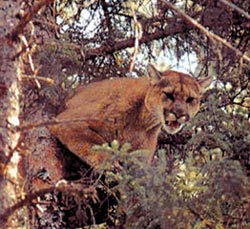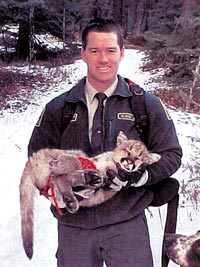|
The Cautions of a Cougar by Ron Weibe When I moved to the Canmore area in November 1999, there was no doubt in my mind that things were different. The wildlife calls and occurrences had some similarities but overall the corridors and proximity of the town itself created altogether different issues. I attended my first cougar-related call in December that year. Right on the edge of town a couple had left their Akita dog out till they returned home that evening. Much to their surprise a cougar found the dog to be more appealing than they. The cougar took it virtually off the steps, tore its throat out and dragged it down to the bush for dinner. Over the next year we received complaints that cougars had been sighted in and around town. There were complaints that the odd dog and cat had gone missing. A climber up at Grassi Lakes came face to face with a cougar while climbing. He explained that he had quickly descended and left the area Ñ we both felt that had been a wise choice. What it all spelled out is that in places like Canmore, humans and wildlife come in contact very regularly and I was sure I would be learning a lot more about the issue. Almost a year to the day after the Akita's death, I received a call from the veterinarian in Canmore asking if I would like to view a Labrador retriever that had been killed by a cougar. I had already heard another dog had been killed and was to investigate the death up in the Silvertip area of Canmore. It was evident, upon viewing the retriever, that a cougar had killed it. I then proceeded to the residence of Mr. Pele. The family was pretty shook up. They had found the dog dead on the bottom portion of a two-tier deck right outside their patio doors. From the blood on the deck and the blood smeared on the glass railing it was evident there was little struggle, as the biggest challenge the cougar had was how to get it off the deck. It appeared the cat couldn't lift the dog over the railing as it was all closed in. Something must have frightened the big cat away. I called a local dog handler and guide, Flint Simpson. Flint's experience with cats was very valuable and it was determined that the cat was a female. We tracked the cougar until dark and headed back in. I left my number with the Peles, should the cat return. It did several times and did so even at 2 p.m., two days later, staring in the upper deck window of the residence, while the Pele family was inside. This again unnerved the family. The parents wondered if they or their children could be next on the menu. Of course we assured them this was very uncommon behavior and to be very cautious. We would try to deal with the cat. Before this time I had contacted the regional problem wildlife specialist, Stan Hawes out of Cochrane. C.O. Hawes agreed something had to be done and we began planning how to deal with the cougar. In light of past situations we agreed it best to bring in another dog handler from the Cochrane area, Tuff and Drew Ramsey as well as Flint Simpson and his dogs. We had been consulting with the local biologist and district officer meanwhile and had already briefed the area manager, Ray Andrews.
On December 16, 2000, seven days after the Pele dog was killed, the cougar was back at the family's house again. Apparently the cougar wanted to have her dog and eat it too. That evening plans were made with C.O. Hawes and with Simpson and Ramsey to work with the dogs at first light. This was to be the first and last time I would deal with this cougar directly. At 7:30 the next morning I loaded a bear trap with a bale that was to be the cougar's home once it was treed by the dogs and tranquilized. At that time consultation was to determine the fate of the big cat. There was some question as to whether it had kittens or not. We had poor evidence from tracks as we had very little snow that season. Eight o'clock rolled around and several conservation officers met, as well as all the dog handlers and a local RCMP member, Al Stockley. We went through the concerns and intentions to capture and hold the cat. Two members of our team, Rod Jaeger and Drew Ramsey, tracked the cougar from her last known location. This provided us continuity and confirmation that this was our cat. Tuff and Drew Ramsey, Flint Simpson and Al Stockley readied the dogs. Officers Stan Hawes, Rod Jaeger and I prepared to tree the cat. Tuff seemed to jump the big cat first even though tracks were around us everywhere. He worked separately from the other dogs. Once the cougar was jumped we found the remnants of a freshly eaten cat that the local people recognized as someone's pet. The tracking continued until the cat was treed. She stayed up there for only a short time, as we didn't have a chance to immobilize her. After the third time the cougar was treed, I finally darted her. As luck would have it something failed and the cougar came out of the tree again. This time with no intent to be chased by the dogs, she got ahead of the hounds and waited in attack mode. The moment they rounded the corner the cougar was on the dogs. She ate ones this size regularly. Right behind the dogs was Flint, Al and me. All that was visible was a big ball of cougar and dogs. Nobody was winning and positions changed rapidly. Flint grabbed the first dog but not before the cougar took a leap toward him. He yelled for us to grab a dog and tie it up. Al grabbed the next dog and as I got into the ball of fury and teeth I could see big Red was in the teeth of the cougar. I shot the big cat with another dart and tried to separate the dogs and the cat. Al was behind me yelling that this wasn't going well. That thought had actually crossed my mind already. At this time I began kicking the cougar and pushing dogs aside in hope that the cat would attempt to get away. She just stared at me with those big eyes and when the chance came she wouldn't leave. Al joined in the effort and began helping, as Flint took out another dog or two. I recall both of us actually kicking the cat, trying to separate it from the dog, while wondering where those teeth would go next. With Al still giving me support, the only chance came as I drew my .40 calibre glock pistol and shot the big cat once in the head. All was quiet once again until I heard my cell phone ring. It was Stan Hawes asking what happened as he had remained back and was setting up another dart All this happened faster than one had any time to reflect upon. The decisions we made at that moment were criticized by many and supported by as many more. Overall the issue at hand was safety: for the public, the team, the dogs and the cougar. Unfortunately, as I was advised by one good officer, ÒThings have a way of going south". This was true. I have learned from the whole incident that we live in corridors and fringe areas where we will have continued confrontations. The people who live in these areas need to consider everything they do in a different way, to enable wild animals to live normal lives that don't habituate them, such as this cougar had been. It's usually the complete series of events and circumstances that lead the officer into a situation that may Ògo south." But the conservation officer still has to perform his job no matter how much the situation is stacked against his best efforts.
Ron
Wiebe is a member of
|
|
|

 Due
to the extreme cold we had experienced at the time we were unable to
run the cougar with dogs. The political turmoil hit its peak with the
RCMP being involved in complaints from the public as well as the newspaper
and letters to the editor making a circus of the issue. Cougar sightings
were being called in and another attack was investigated. Phone calls
were being received at the office and at officers' residential numbers.
But nothing compared to the calls we were to receive within a few days.
Due
to the extreme cold we had experienced at the time we were unable to
run the cougar with dogs. The political turmoil hit its peak with the
RCMP being involved in complaints from the public as well as the newspaper
and letters to the editor making a circus of the issue. Cougar sightings
were being called in and another attack was investigated. Phone calls
were being received at the office and at officers' residential numbers.
But nothing compared to the calls we were to receive within a few days. The
final saga of this cougar was that it actually did have two kittens.
We were initially unsuccessful in our search, due to poor snow conditions.
The media followed the events daily. Two weeks later, just after a snowstorm
and three days of tracking I finally cut the kitten's tracks. They were
already going to town for one reason or another and one kitten had died.
The surviving kitten ended up at Calgary Zoo and was later sent to the
Granby Zoo in Ontario. All in all, a lot of hours were spent and a lot
of teamwork was logged.
The
final saga of this cougar was that it actually did have two kittens.
We were initially unsuccessful in our search, due to poor snow conditions.
The media followed the events daily. Two weeks later, just after a snowstorm
and three days of tracking I finally cut the kitten's tracks. They were
already going to town for one reason or another and one kitten had died.
The surviving kitten ended up at Calgary Zoo and was later sent to the
Granby Zoo in Ontario. All in all, a lot of hours were spent and a lot
of teamwork was logged.